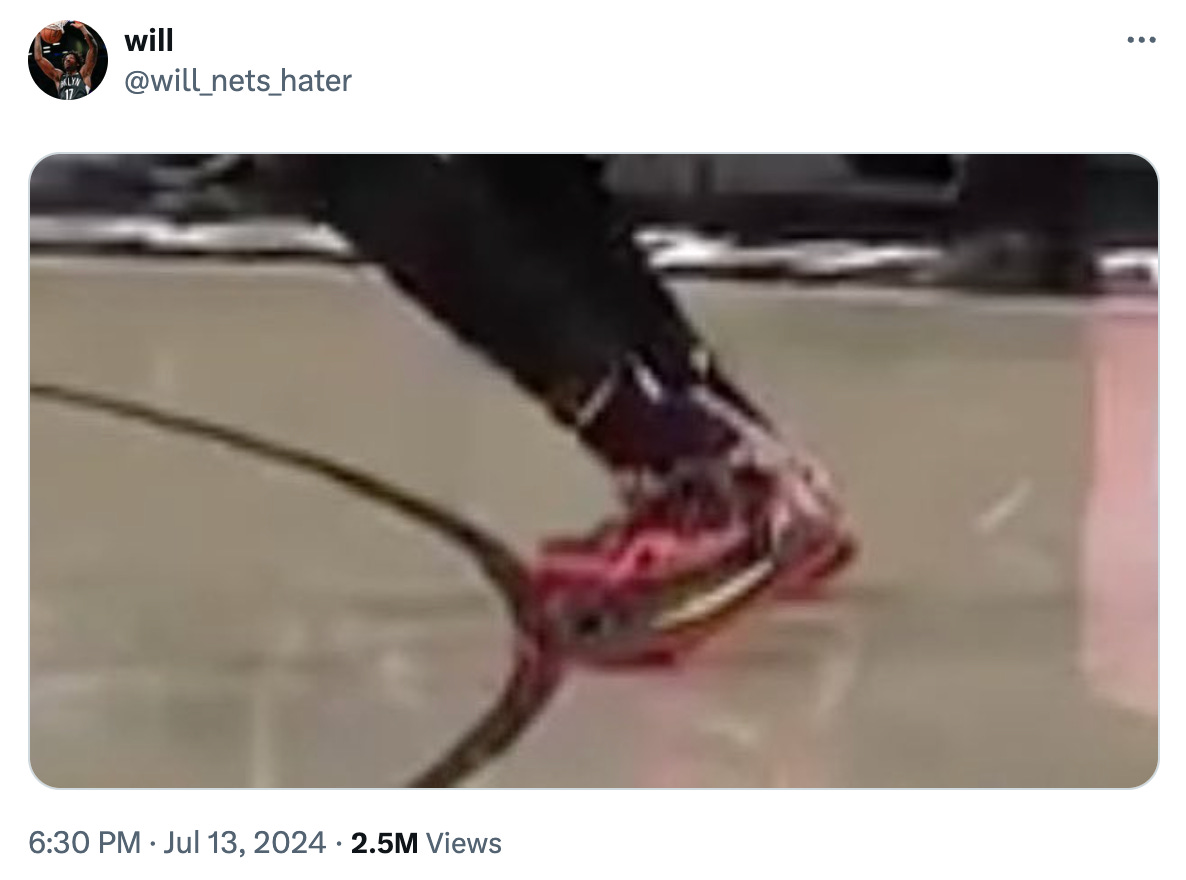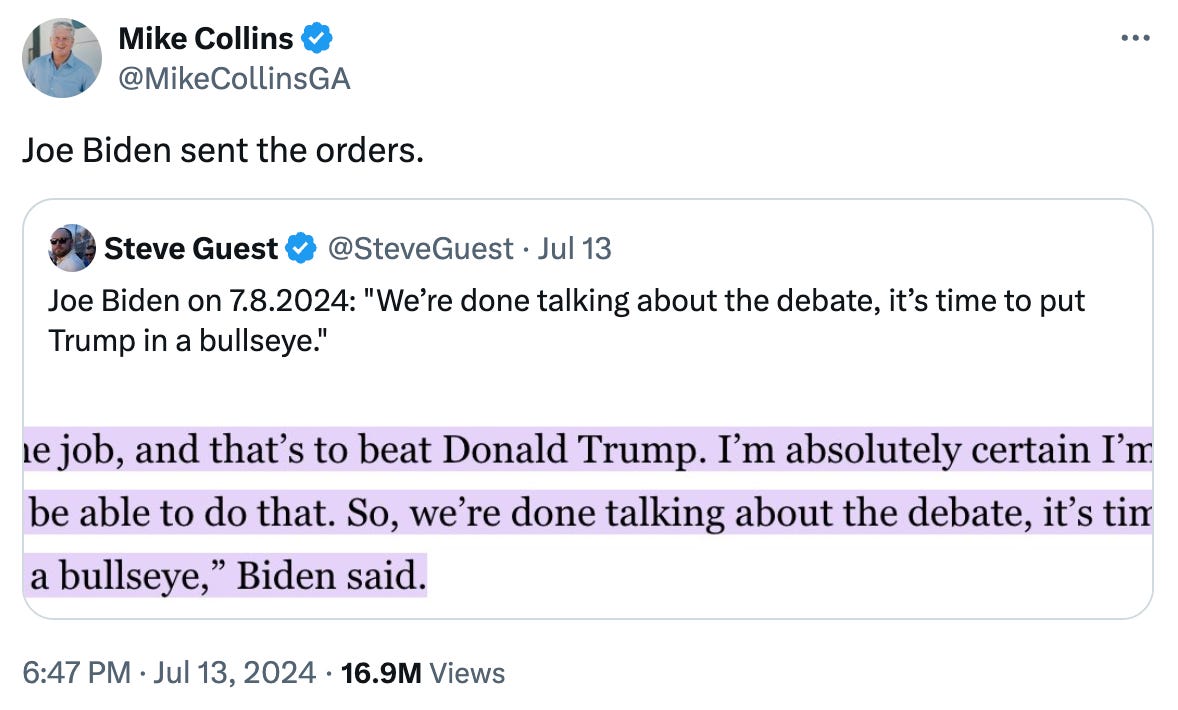24 Hours On X After The Attempted Assassination of Donald Trump
An Informal Case Study
Welcome to a special edition of Noise Level.
There’s no way to sugarcoat this. Between now and November, things are going to be messy. And there will be moments, like what happened Saturday in Pennsylvania, that create significant noise and seismic shifts in mindsets.
To help you make sense of these moments culturally and in your own media consumption, we’ll be popping into your inbox with occasional mid-week articles like this one.
Breaking News + Basketball
Despite its declining dominance in the social media world, X (fka Twitter) is still the digital town square many turn to amid breaking news to watch a story and its associated hot takes unfold. Its diehard users include an unparalleled mix of politicians, journalists, conspiracy influencers, and, well, me.
As an avid New York Knicks fan and a political junkie, my Twitter feed largely consists of two very different subjects: the NBA and American politics. Saturday night was no different, and the first tweet to load on my phone was a grim combination of the two.
If you’re a basketball fan, you may recognize this often-meme’d photo of then-Brooklyn Nets star Kevin Durant’s foot in the 2021 NBA playoffs. The photo comes from a slow-motion review of a last-minute three-point shot to win a game 7 against the Milwaukee Bucks. Durant’s toe was just slightly over the three-point line and, thus, his shot was ruled a two-pointer and the Nets lost the series. This photo is a common meme among NBA fans to insinuate that someone had failed by only the slimmest margin. He would have pulled it off if he were just an inch to the side.
After a very odd minute or two of the Twitter algorithm’s best efforts to show me combination NBA and political violence content, the actual news began to surface.
Here are the primary threads I picked up on X that night:
Thoughts, Prayers, and Party Lines
A plurality of online accounts, particularly established leaders in American discourse, posted what most of us would expect to see when tragedy strikes - a calm, measured, and inoffensive response. Political leaders from both sides of the aisle, as well as popular pundits, offered their thoughts for former President Trump and those affected by the attack and condemned political violence. In most cases, these posts were unremarkable in contrast to the entire X ecosystem – tame and mature, lacking the elements that unlock virality like humor or anger.
Others, however, struck a more partisan tone, often pointing out their perceived hypocrisy in the other party’s reaction to the shooting. Republicans blamed the assassination attempt on Democrats for their fiery rhetoric and combative messaging, while Democrats accused Republicans of being selective in where they place sympathy for previous acts of political violence, as shown in the tweet above.
Queue The Tinfoil Hats
Unsurprisingly, misinformation was quick to spread in the aftermath of the shooting. There were instantaneous accusations of a coordinated attempt by Antifa, fake profiles of a Hispanic shooter that were posted before we knew any information, and flat-out accusations that President Biden had personally ordered the shooting. The latter saw significant traction in right-wing circles and was amplified by a sitting GOP Congressman.
Another more confusing conspiracy theory proliferated later that night and into the next day. In May of this year, the shooter appeared, coincidentally, in a video made by the financial giant BlackRock. This set off a multitude of abstract (and frankly nonsensical) conspiracy theories that seemed to center around its abject suspiciousness. In one case, a screenshot of the video with the sarcastic quip “probably nothing” has generated almost 20 million views.
The BlackRock conspiracy evolved later this week after several Trump-aligned influencers posted out-of-context financial disclosures from the financial firm Austin Private Wealth LLC, showing a nearly half-a-billion-dollar short position for Trump Media & Technology Group, the parent company of Trump’s Truth Social. The influencers claimed the wealth management firm shorted the company the day before the assassination attempt and had coordinated with BlackRock. In reality, the shorts were both taken out weeks before the shooting and were a $400,000 position – 99% less than originally claimed. The conspiracy, however, had already spread and now includes much darker theories and accusations that we will not link in this newsletter.

 Tiktok failed to load.
Tiktok failed to load.Enable 3rd party cookies or use another browser
The most common conspiracy, however, was that the assassination attempt was staged by the Trump campaign. The accusation was so popular that the word “staged” was the top-trending word for many users in under an hour. The belief of a staged assassination attempt in left-wing circles included observations about how narrowly the shots had missed and disbelief that the Secret Service could have let it happen, likely exacerbated and fueled by feelings of pessimism around what such an attempt would do for Trump’s approval rating.
An analogous conspiracy also spread on the right, positing that the Secret Service had deliberately allowed the assassination attempt to take place. Elon Musk propagated this theory moments after the shooting in a tweet now with nearly 100 million views. This spurred numerous social media posts criticizing the female Secret Service agent on stage that night, with some arguing that DEI policies had put Trump in explicit danger by hiring more women to serve in the agency.
On Tuesday, The Wall Street Journal published a fairly comprehensive account of the conspiracies and misinformation that proliferated in the hours after the shooting. It’s worth a watch.
Meanwhile, The Survey Says…
Naturally, the pundits didn’t miss a beat. Talk of how the assassination attempt would impact the election in November dominated online discourse across platforms. Before we had all the facts and before the identity of the shooter was known, users posted torrents of hot takes across the social universe discussing what this would mean for Trump’s support and Biden’s legitimacy as a candidate. There was massive anxiety about how such an attempt, coupled with the striking photo of a bloodied Trump, would result in skyrocketing approval ratings for the former President, much like we saw after Reagan’s attempted assassination in 1981.
Cringe Currency
Tweets like the one above, along with many other CIA-related jokes, garnered millions of views on the night of the shooting. If you spend considerable time online, you’d know this variety of ‘brain rot’ humor is designed to spark laughs, outrage, and most importantly, reposts. The absurdity of it is the point, and your gut reaction is social media’s currency.
Underneath it, however, is a rich combination of cultural tensions: conspiracy theories about the assassination attempt, partisan politics, DEI, intelligence agencies, etcetera. Is this person earnestly suggesting that the CIA carried out this assassination attempt and was unsuccessful due to DEI hiring policies? Looking at their page and their previous tweets, I can assure you he is not. But, like all jokes, your audience is important and the intended audience of a public tweet is… well, everyone.
It may seem off-color, but there’s a reason why the Twitter algorithm showed me a picture of Kevin Durant’s foot before anything else: people were engaging with that joke more than the real news. The real-time updates about the attempted assassination of a former President lost out to a three-year-old picture of a basketball player’s shoe. If you logged into social media that night, you were shown brief snippets of real information peppered amongst conspiracy theories, misinformation, and jokes about the whole ordeal. Sure, I eventually learned what had transpired and am now as updated as anyone else, but I first witnessed and digested a wide variety of content stretching from the absurd to the outright dangerous.
Even if you are scrolling with a discerning eye and a deliberately critical lens, it’s impossible to parse through the noise crowding your screen and leave with only “the facts.” Instead, we consume the information as the algorithms dictate and leave impacted by all we have seen. In the pre-internet era, an event of this magnitude would bring us to the same TV channels in search of updates. We would all get the same basic set of facts presented similarly. Today, if you get your news from social media, as most Americans do, your experience is vastly different from your neighbor’s and wildly disorienting.
Before the news, you first get a meme of a shoe.









